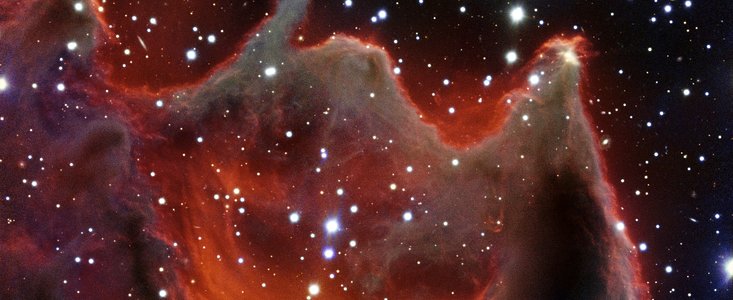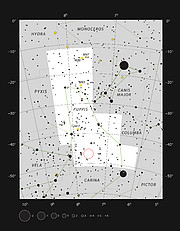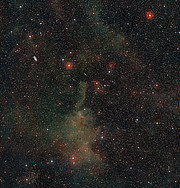Comunicato Stampa
Le fauci del mostro
Il VLT fotografa il globulo cometario CG4
28 Gennaio 2015
Come fauci spalancate di una gigantesca creatura celeste, il globulo cometario CG4 risplende minaccioso in questa nuova immagine presa dal VLT (Very Large Telescope) dell'ESO. Anche se sembra grande e luminosa in questa fotografia, è invece una nebulosa piuttosto debole, così che è arduo per un astronomo dilettante individuarla. La reale natura di CG4 rimane ancora incognita.
Nel 1976 vennero scoperti numerosi oggetti allungati, simili a comete, nelle immagini ottenute con il telescopio Schmidt del Regno Unito, in Australia. A causa del loro aspetto divennero noti come globuli cometari anche se non hanno nulla in comune con le comete. Si trovavano tutti in una grande zona di gas incandescente nota come Nebulosa di Gum e avevano una "testa" scura, densa e polverosa e una "coda" lunga e debole, di solito rivolta in direzione opposta rispetto al resto di supernova delle Vele, al centro della Nebulosa di Gum. Anche se questi oggetti sono relativamente vicini, non è stato facile per gli astronomi trovarli, poichè sono molto deboli e perciò difficili da rivelare.
L'oggetto mostrato in questa nuova immagine, CG4, chiamato talvolta anche "la mano di dio" è uno di questi globuli cometari. Si trova a circa 1300 anni luce dalla Terra, nella costellazione della Poppa.
La testa di CG4, visibile in questa immagine, sembra la testa di un mostro gigante e ha un diametro di 1,5 anni luce. La coda del globulo - che si estende verso il basso e non è visibile in questa inquadratura - è lunga circa 8 anni luce. Su scala astronomica, è una nube abbastanza piccola.
Le modeste dimensioni sono una caratteristica comune dei globuli cometari. Tutti quelli finora trovati sono nubi relativamente piccole e isolate di gas neutro e polvere all'interno della Via Lattea, circondate da materiale caldo e ionizzato.
La zona della "testa" di CG4 è una densa nube di gas e polvere, visibile solo perchè illuminata dalla luce delle stelle vicine. La radiazione emessa da queste stelle sta gradualmente distruggendo la testa del globulo erodendo le minuscole particelle che diffondono la luce stellare. Ma la nube di CG4 contiene ancora abbastanza gas per formare numerose stelle della dimensione del Sole e infatti CG4 sta proprio formando nuove stelle: la loro formazione è forse innescata dalla radiazione delle stelle che forniscono energia alla Nebulosa di Gum, quando raggiunge CG4.
Perchè CG4 e altri globuli cometari abbiano questa forma è ancora oggetto di dibattito tra gli astronomi: si sono sviluppate due diverse teorie. I globuli cometari, e perciò anche CG4, potrebbero essere stati in orginie delle nebulose sferiche, distorte da un'esplosione di supernova abbastanza vicina da aver dato loro questa forma nuova e strana. Altri astronomi suggeriscono invece che i globuli cometari siano modellati dai venti stellari e dalla radiazione ionizzante di stelle calde e massicce di tipo OB. Questi effetti potrebbero portare iniziamente alle formazioni dal nome bizzaro (ma appropiato!) di proboscidi di elefante e quindi ai globuli cometari.
Per capirne di più, gli astronomi devono scoprire la massa, la densità, la temperatura e la velocità del materiale che forma i globuli. Questi parametri possono essere determinati dalle misure delle righe spettrali molecolari accessibili a lunghezze d'onda millimetriche - proprio quelle a cui operano i telescopi come ALMA (Atacama Large Millimeter/submillimeter Array).
Questa immagine è stata ottenuta nel corso del programma Gemme Cosmiche dell'ESO, un'iniziativa tesa a produrre immagini di oggetti astronomici interessanti o anche semplicemente belli utilizzando i telescopi dell'ESO a scopi di istruzione e divulgazione. Il programma sfrutta il tempo in cui il telescopio non può essere usato per osservazioni scientifiche. Tutti i dati raccolti potrebbero comunque essere usati per scopi scientifici e sono disponibili agli astronomi tramite l'archivio scientifico dell'ESO.
Ulteriori Informazioni
L'ESO (European Southern Observatory, o Osservatorio Australe Europeo) è la principale organizzazione intergovernativa di Astronomia in Europa e l'osservatorio astronomico più produttivo al mondo. È sostenuto da 15 paesi: Austria, Belgio, Brasile, Danimarca, Finlandia, Francia, Germania, Gran Bretagna, Italia, Olanda, Portogallo, Repubblica Ceca, Spagna, Svezia, e Svizzera. L'ESO svolge un ambizioso programma che si concentra sulla progettazione, costruzione e gestione di potenti strumenti astronomici da terra che consentano agli astronomi di realizzare importanti scoperte scientifiche. L'ESO ha anche un ruolo di punta nel promuovere e organizzare la cooperazione nella ricerca astronomica. L'ESO gestisce tre siti osservativi unici al mondo in Cile: La Silla, Paranal e Chajnantor. Sul Paranal, l'ESO gestisce il Very Large Telescope, osservatorio astronomico d'avanguardia nella banda visibile e due telescopi per survey. VISTA, il più grande telescopio per survey al mondo, lavora nella banda infrarossa mentre il VST (VLT Survey Telescope) è il più grande telescopio progettato appositamente per produrre survey del cielo in luce visibile. L'ESO è il partner principale di ALMA, il più grande progetto astronomico esistente. E sul Cerro Armazones, vicino al Paranal, l'ESO sta costruendo l'European Extremely Large Telescope o E-ELT (significa Telescopio Europeo Estremamente Grande), un telescopio da 39 metri che diventerà "il più grande occhio del mondo rivolto al cielo".
La traduzione dall'inglese dei comunicati stampa dell'ESO è un servizio dalla Rete di Divulgazione Scientifica dell'ESO (ESON: ESO Science Outreach Network) composta da ricercatori e divulgatori scientifici da tutti gli Stati Membri dell'ESO e altri paesi. Il nodo italiano della rete ESON è gestito da Anna Wolter.
Links
Contatti
Richard Hook
ESO education and Public Outreach Department
Garching bei München, Germany
Tel.: +49 89 3200 6655
Cell.: +49 151 1537 3591
E-mail: rhook@eso.org
Anna Wolter (press contact Italia)
Rete di divulgazione scientifica dell'ESO
e INAF-Osservatorio Astronomico di Brera
Milano, Italy
Tel.: +39 02 72320321
E-mail: eson-italy@eso.org
Sul Comunicato Stampa
| Comunicato Stampa N": | eso1503it |
| Nome: | CG4 |
| Tipo: | Milky Way : Nebula : Type : Star Formation |
| Facility: | Very Large Telescope |
| Instruments: | FORS1 |
Our use of Cookies
We use cookies that are essential for accessing our websites and using our services. We also use cookies to analyse, measure and improve our websites’ performance, to enable content sharing via social media and to display media content hosted on third-party platforms.
ESO Cookies Policy
The European Organisation for Astronomical Research in the Southern Hemisphere (ESO) is the pre-eminent intergovernmental science and technology organisation in astronomy. It carries out an ambitious programme focused on the design, construction and operation of powerful ground-based observing facilities for astronomy.
This Cookies Policy is intended to provide clarity by outlining the cookies used on the ESO public websites, their functions, the options you have for controlling them, and the ways you can contact us for additional details.
What are cookies?
Cookies are small pieces of data stored on your device by websites you visit. They serve various purposes, such as remembering login credentials and preferences and enhance your browsing experience.
Categories of cookies we use
Essential cookies (always active): These cookies are strictly necessary for the proper functioning of our website. Without these cookies, the website cannot operate correctly, and certain services, such as logging in or accessing secure areas, may not be available; because they are essential for the website’s operation, they cannot be disabled.
Functional Cookies: These cookies enhance your browsing experience by enabling additional features and personalization, such as remembering your preferences and settings. While not strictly necessary for the website to function, they improve usability and convenience; these cookies are only placed if you provide your consent.
Analytics cookies: These cookies collect information about how visitors interact with our website, such as which pages are visited most often and how users navigate the site. This data helps us improve website performance, optimize content, and enhance the user experience; these cookies are only placed if you provide your consent. We use the following analytics cookies.
Matomo Cookies:
This website uses Matomo (formerly Piwik), an open source software which enables the statistical analysis of website visits. Matomo uses cookies (text files) which are saved on your computer and which allow us to analyze how you use our website. The website user information generated by the cookies will only be saved on the servers of our IT Department. We use this information to analyze www.eso.org visits and to prepare reports on website activities. These data will not be disclosed to third parties.
On behalf of ESO, Matomo will use this information for the purpose of evaluating your use of the website, compiling reports on website activity and providing other services relating to website activity and internet usage.
Matomo cookies settings:
Additional Third-party cookies on ESO websites: some of our pages display content from external providers, e.g. YouTube.
Such third-party services are outside of ESO control and may, at any time, change their terms of service, use of cookies, etc.
YouTube: Some videos on the ESO website are embedded from ESO’s official YouTube channel. We have enabled YouTube’s privacy-enhanced mode, meaning that no cookies are set unless the user actively clicks on the video to play it. Additionally, in this mode, YouTube does not store any personally identifiable cookie data for embedded video playbacks. For more details, please refer to YouTube’s embedding videos information page.
Cookies can also be classified based on the following elements.
Regarding the domain, there are:
- First-party cookies, set by the website you are currently visiting. They are stored by the same domain that you are browsing and are used to enhance your experience on that site;
- Third-party cookies, set by a domain other than the one you are currently visiting.
As for their duration, cookies can be:
- Browser-session cookies, which are deleted when the user closes the browser;
- Stored cookies, which stay on the user's device for a predetermined period of time.
How to manage cookies
Cookie settings: You can modify your cookie choices for the ESO webpages at any time by clicking on the link Cookie settings at the bottom of any page.
In your browser: If you wish to delete cookies or instruct your browser to delete or block cookies by default, please visit the help pages of your browser:
Please be aware that if you delete or decline cookies, certain functionalities of our website may be not be available and your browsing experience may be affected.
You can set most browsers to prevent any cookies being placed on your device, but you may then have to manually adjust some preferences every time you visit a site/page. And some services and functionalities may not work properly at all (e.g. profile logging-in, shop check out).
Updates to the ESO Cookies Policy
The ESO Cookies Policy may be subject to future updates, which will be made available on this page.
Additional information
For any queries related to cookies, please contact: pdprATesoDOTorg.
As ESO public webpages are managed by our Department of Communication, your questions will be dealt with the support of the said Department.





